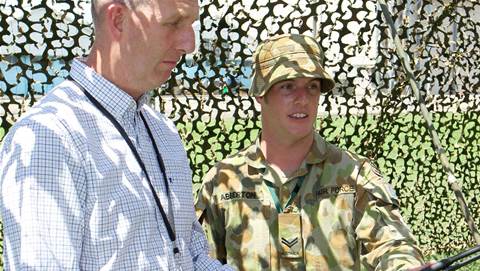Other efforts

Allen says the data centre is in effect the final place NAB has looked to cut down on its carbon footprint.
The bank has already transferred its vehicle fleet to hybrid energy cars, mandated standard building requirements to include energy efficiency, and now insists on turning office lights off at 7pm, with exceptions of no longer than thirty minutes.
IT was "the sleeping dragon in the carbon footprint issue," Allen said.
"No one cared about energy use in technology areas before this," he said. "It has been a real turnaround."
When the IT operations staff were first asked to produce a number for how much power its data centre uses, auditors "asked if we'd left an extra zero in there."
"We looked at it and said, no, that's actually what we're using," Allen says. "That put us under some pressure to look at this."
The challenge, Allen says, is that Green IT is "so nebulus". Most IT operations haven't accounted for their use of power in the past nor have they had any metrics to compare it to.
"The more you measure, the more you realise IT is distributed throughout the organisation - right down to sitting there on the belt of your end users [their Blackberry]," Allen says.
"Before I could look at data centres, I was looking at sleep states on PCs."
Making changes at the end user level and at the level of the data centre are "two very different things", Allen said.
"It's like turning an ant around compared to turning around the Titanic. The data centre is a long-term journey."
Stage one of the data centre journey saw NAB invest in virtualisation technology to consolidate its servers.
Allen is somewhat disappointed with the results.
"There is a lot of myth around virtualisation and its capacity to reduce your carbon footprint," he said. "The reality is, it's very hard work. It's not as easy as the VMware brochure makes it look."
Allen thinks it's likely to be smaller businesses with "flat architectures" (less operating systems) that are in the "sweet spot" for virtualisation. He highly doubts that any enterprise data centres are achieving the purported server consolidation ratios of 15:1 or 20:1 when they invest in virtualisation.
"In the bowels of the industry, you might be lucky to get 50 per cent capacity out of a server that previously had ten to fifteen per cent capacity in use. And processors might be able to run at 80 per cent capacity, but then you can run into bandwidth issues. SANs slow down and there is too much data through too few ports."
Allen also doubts the capacity of virtual desktops to reduce carbon use - conscious that pulling heat loads off the desktop only pulls it back into the data centre.
NAB is now "resetting our expectations of virtualisation to a lower mark."
Allen will be presenting an in-depth look at NAB's journey to become carbon neutral at the 2009 Data Centre Summit in June.



.png&h=140&w=231&c=1&s=0)





.png&w=100&c=1&s=0)

 iTnews Benchmark Security Awards 2025
iTnews Benchmark Security Awards 2025
 Digital Leadership Day Federal
Digital Leadership Day Federal
 Government Cyber Security Showcase Federal
Government Cyber Security Showcase Federal
 Government Innovation Showcase Federal
Government Innovation Showcase Federal
 Digital NSW 2025 Showcase
Digital NSW 2025 Showcase











_(1).jpg&h=140&w=231&c=1&s=0)



